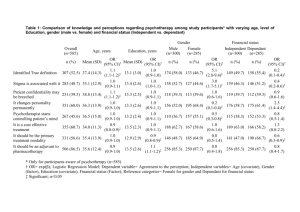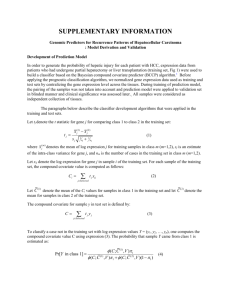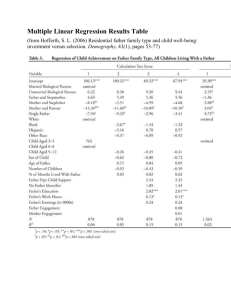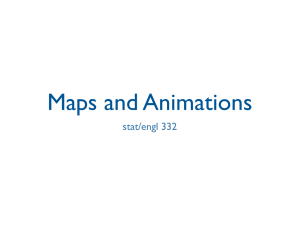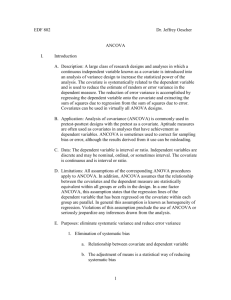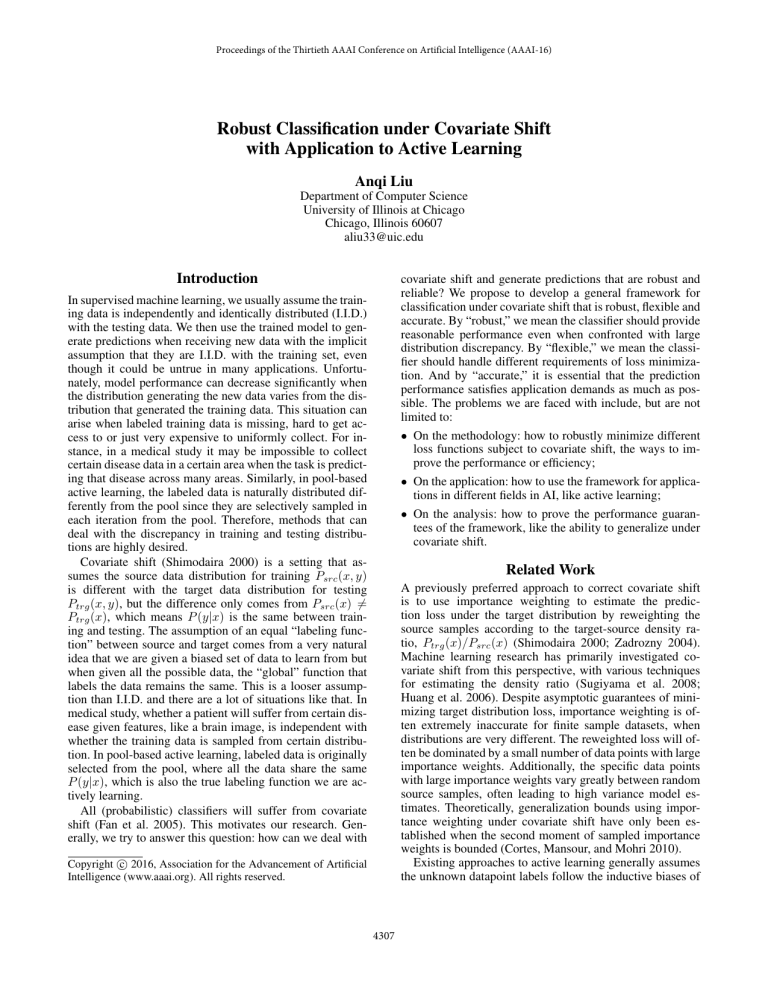
Proceedings of the Thirtieth AAAI Conference on Artificial Intelligence (AAAI-16)
Robust Classification under Covariate Shift
with Application to Active Learning
Anqi Liu
Department of Computer Science
University of Illinois at Chicago
Chicago, Illinois 60607
aliu33@uic.edu
Introduction
covariate shift and generate predictions that are robust and
reliable? We propose to develop a general framework for
classification under covariate shift that is robust, flexible and
accurate. By “robust,” we mean the classifier should provide
reasonable performance even when confronted with large
distribution discrepancy. By “flexible,” we mean the classifier should handle different requirements of loss minimization. And by “accurate,” it is essential that the prediction
performance satisfies application demands as much as possible. The problems we are faced with include, but are not
limited to:
• On the methodology: how to robustly minimize different
loss functions subject to covariate shift, the ways to improve the performance or efficiency;
• On the application: how to use the framework for applications in different fields in AI, like active learning;
• On the analysis: how to prove the performance guarantees of the framework, like the ability to generalize under
covariate shift.
In supervised machine learning, we usually assume the training data is independently and identically distributed (I.I.D.)
with the testing data. We then use the trained model to generate predictions when receiving new data with the implicit
assumption that they are I.I.D. with the training set, even
though it could be untrue in many applications. Unfortunately, model performance can decrease significantly when
the distribution generating the new data varies from the distribution that generated the training data. This situation can
arise when labeled training data is missing, hard to get access to or just very expensive to uniformly collect. For instance, in a medical study it may be impossible to collect
certain disease data in a certain area when the task is predicting that disease across many areas. Similarly, in pool-based
active learning, the labeled data is naturally distributed differently from the pool since they are selectively sampled in
each iteration from the pool. Therefore, methods that can
deal with the discrepancy in training and testing distributions are highly desired.
Covariate shift (Shimodaira 2000) is a setting that assumes the source data distribution for training Psrc (x, y)
is different with the target data distribution for testing
Ptrg (x, y), but the difference only comes from Psrc (x) =
Ptrg (x), which means P (y|x) is the same between training and testing. The assumption of an equal “labeling function” between source and target comes from a very natural
idea that we are given a biased set of data to learn from but
when given all the possible data, the “global” function that
labels the data remains the same. This is a looser assumption than I.I.D. and there are a lot of situations like that. In
medical study, whether a patient will suffer from certain disease given features, like a brain image, is independent with
whether the training data is sampled from certain distribution. In pool-based active learning, labeled data is originally
selected from the pool, where all the data share the same
P (y|x), which is also the true labeling function we are actively learning.
All (probabilistic) classifiers will suffer from covariate
shift (Fan et al. 2005). This motivates our research. Generally, we try to answer this question: how can we deal with
Related Work
A previously preferred approach to correct covariate shift
is to use importance weighting to estimate the prediction loss under the target distribution by reweighting the
source samples according to the target-source density ratio, Ptrg (x)/Psrc (x) (Shimodaira 2000; Zadrozny 2004).
Machine learning research has primarily investigated covariate shift from this perspective, with various techniques
for estimating the density ratio (Sugiyama et al. 2008;
Huang et al. 2006). Despite asymptotic guarantees of minimizing target distribution loss, importance weighting is often extremely inaccurate for finite sample datasets, when
distributions are very different. The reweighted loss will often be dominated by a small number of data points with large
importance weights. Additionally, the specific data points
with large importance weights vary greatly between random
source samples, often leading to high variance model estimates. Theoretically, generalization bounds using importance weighting under covariate shift have only been established when the second moment of sampled importance
weights is bounded (Cortes, Mansour, and Mohri 2010).
Existing approaches to active learning generally assumes
the unknown datapoint labels follow the inductive biases of
c 2016, Association for the Advancement of Artificial
Copyright Intelligence (www.aaai.org). All rights reserved.
4307
• The application: We will continue exploring more sophisticated label strategies that will benefit us in both practice and theory in active learning. In addition, we will explore applications in other areas in broader context of AI
to which our robust framework could contribute.
• The analysis: We would like to figure out the generalization error analysis under covariate shift setting because
the expected target error no longer relates with the training error in the same way in the I.I.D. setting. We are also
curious about relation between our model performance
and the source-target discrepancy in theory.
the active learner. However, as previously stated, data produced from an active learner violates the I.I.D. data property
broadly assumed by supervised machine learning techniques
(Settles 2012). It poses serious pitfalls for active learning
methods both in theory and in practice that have not yet been
resolved. Current solutions using random labeled seed examples to start with or sampling from mixed strategies usually aim to make label solicitation more random, which undermines the advantages of active learning.
Current Progress
We proposed a novel approach to classification that embraces the uncertainty resulting from covariate shift (Liu
and Ziebart 2014). Based on minimax robust estimation
(Topsøe 1979; Grünwald and Dawid 2004), our approach is
the worst-case distribution possible for a given loss function.
We first focused on expected logarithmic loss minimization
under covariate shift. The resulting robust bias-aware (RBA)
classifier robustly minimizes the logarithmic loss of the target prediction task subject to known properties of data from
the source distribution. The parameters of the classifier are
optimized via convex optimization to match statistical properties measured from the source distribution.
Active learning, as an important application where natural
covariate shift exists, is one of the main components in my
research. The RBA classifier is applied to active learning by
considering the problem as a covariate shift prediction task
and adopting pessimism about all uncertain properties of
the conditional label distribution (Liu, Reyzin, and Ziebart
2015). Theoretically, this aligns model uncertainty with prediction loss on remaining unlabeled data points, better justifying the use of the model’s label estimates within active
learning label solicitation strategies. Moreover, thanks to the
cost sensitive method developed recently (Asif et al. 2015),
the active learning framework using adversarial prediction is
tractable in the 0-1 loss minimization under covariate shift.
So it is also applied to active learning in a workshop paper
(Liu et al. 2015), even though further effort to improve the
performance is still required.
References
Asif, K.; Xing, W.; Behpour, S.; and Ziebart, B. D. 2015.
Adversarial cost-sensitive classification. In Proceedings of
the Conference on Uncertainty in Artificial Intelligence.
Cortes, C.; Mansour, Y.; and Mohri, M. 2010. Learning
bounds for importance weighting. In Advances in Neural
Information Processing Systems, 442–450.
Fan, W.; Davidson, I.; Zadrozny, B.; and Yu, P. S. 2005. An
improved categorization of classifier’s sensitivity on sample
selection bias. In Proc. of the IEEE International Conference on Data Mining, 605–608.
Grünwald, P. D., and Dawid, A. P. 2004. Game theory, maximum entropy, minimum discrepancy, and robust Bayesian
decision theory. Annals of Statistics 32:1367–1433.
Huang, J.; Smola, A. J.; Gretton, A.; Borgwardt, K. M.; and
Schlkopf, B. 2006. Correcting sample selection bias by unlabeled data. In Advances in Neural Information Processing
Systems, 601–608.
Liu, A., and Ziebart, B. D. 2014. Robust classification under
sample selection bias. In Advances in Neural Information
Processing Systems.
Liu, A.; Asif, K.; Xing, W.; Behpour, S.; D. Ziebart, B.; and
Reyzin, L. 2015. Addressing covariate shift in active learning with adversarial prediction. ICML 2015 workshop of
Active learning.
Liu, A.; Reyzin, L.; and Ziebart, B. D. 2015. Shiftpessimistic active learning using robust bias-aware prediction. In AAAI Conference on Artificial Intelligence.
Settles, B. 2012. Active learning. Synthesis Lectures on
Artificial Intelligence and Machine Learning 6(1):1–114.
Shimodaira, H. 2000. Improving predictive inference under covariate shift by weighting the log-likelihood function.
Journal of Statistical Planning and Inference 90(2):227–
244.
Sugiyama, M.; Nakajima, S.; Kashima, H.; Buenau, P. V.;
and Kawanabe, M. 2008. Direct importance estimation with
model selection and its application to covariate shift adaptation. In Advances in Neural Information Processing Systems, 1433–1440.
Topsøe, F. 1979. Information theoretical optimization techniques. Kybernetika 15(1):8–27.
Zadrozny, B. 2004. Learning and evaluating classifiers under sample selection bias. In Proceedings of the International Conference on Machine Learning, 903–910. ACM.
Future Plans
We plan to further develop this robust classification framework under covariate shift in the following three directions
followed by problems we would want to solve:
• The methodology: We are now extending the method using kernel representation of features. And we would also
like to develop the methodology of the framework in two
aspects: a) The RBA classifier depends on a density ratio
Psrc (x)/Ptrg (x) to control how much the features from
source data generalizes to the target and scale certainty
of the prediction. Apart from using ad-hoc density estimation methods, we will study different ways to obtain
density ratio and figure out the requirement for the density ratio. b) We would also adapt the method to slightly
different problem settings. For example, when we have
multiple sources data, how can we utilize connections between them to deal with covariate shift in that case?
4308

